Idaho National Laboratory
In This Document
Summary
Detectable concentrations of chlorofluorocarbons (CFCs), sulfur hexafluoride (SF6), helium (He), and tritium (3H) were observed in ground water at the Idaho National Laboratory (INL) and vicinity. These transient tracers were introduced into the Snake River Plain aquifer by natural recharge, agricultural return flow of irrigation water, and the disposal of wastewater at various facilities at the INEEL. The source of the water, the fraction of young water, as well as the concentration of the tracers in the sample must be known to date the ground water.
Concentrations of transient tracers, chloride (Cl), fluoride (F), oxygen isotope ratios (δ 18O), dissolved atmospheric gases, helium (He), tritium (3H), boron (B), lithium (Li), strontium (Sr) were used to determine the various sources of water in Snake River Plain aquifer at INEEL and vicinity. Ground water mixing fractions were calculated for the various sources of water. The main types of ground water were identified from their gas compositions, chemistry, and isotopic ratios. The regional ground waters were locally modified by agricultural runoff, local natural recharge, and by wastewater from the various facilities at INEEL. The chemistry, carbon-14 (14C), carbon-13/carbon-12 ratios (δ 13C), and δ 18O concentrations were used to calculate the fraction of young water in the samples from western INEEL.
The model recharge ages of young fraction of water were determined using three different dating methods. The results indicate that significant amount of young ground water was added at various locations to the older regional ground water (greater than 50 years) within and outside the INEEL boundaries. A preferential ground water flow path was identified and extends from the Little Lost River sinks and Big Lost River sinks southward through central INEEL past Big Southern Butte. Young ground water is also present in southeastern INEEL in an area extending from the Arbor Test well to the Atomic City well. Other areas with young ground water are located southwest of Terreton, near P&W 2 well, southeast of Howe, and southeast of Arco.
The recharge temperatures were calculated from N2 (nitrogen) Ar (argon) concentrations for many of the ground waters and are about 6°C (degrees Celsius) in the underflow from Birch Creek, Little Lost River, and Big Lost River. The recharge temperatures of between 9 and 13°C were calculated for the Snake River Plain aquifer at INEEL.
Ground waters near and south of the Radioactive Waste Management Complex (RWMC), the Test Reactor Area (TRA), and the Idaho Nuclear Technology and Engineering Complex (INTEC) contain levels of CFCs that are indicative of contamination. A large CFC-12 waste plume originating in the vicinity of TRA extends beyond the southern boundary of the site.
Age dating ground water by use of chlorofluorocarbons CCl3F and CCl2F2) and the distribution of chlorofluorocarbons in the unsaturated zone, Snake River Plain aquifer, Idaho National Engineering Laboratory, Idaho (U.S. Geological Survey Water-Resources Investigations 93-4054 (DOE/ID-22107), 47 p., 1993)
Detectable concentrations of chlorofluorocarbons (CFC's)
were observed inground water and unsaturated-zone air at
the Idaho National Engineering Laboratory (INEL) and vicinity.
The recharge ages of waters were determined to be from 4
to more than 50 years on the basis of CFC concentrations
and other environmental data; most ground waters have ages
of 14 to 30 years. These results indicate that young ground
water was added at various locations to the older regional
ground water (greater than 50 years) within and outside
the INEL boundaries. The wells drilled into the Snake River
Plain aquifer at INEL sampled mainly this local recharge.
The Big Lost River, Birch Creek, the Little Lost River,
and the Mud Lake-Terreton area appear to be major sources
of recharge of the Snake River Plain aquifer at INEL.
An average recharge temperature of 9.7 1.3oC (degrees Celsius)
was calculated from dissolved nitrogen and argon concentrations
in the ground waters, a temperature that is similar to the
mean annual soil temperature of 9oC measured at INEL. This
similarity indicates that the aquifer was recharged at INEL
and not at higher elevations that would have cooler soil
temperatures than INEL.
Soil-gas concentrations at Test Area North (TAN) are explained by diffusion theory. The measured difference between apparent ages based on CFC-11 and CFC-12 concentrations is 7.5 years for the soil atmosphere near the water table at TAN. If ground-water recharged by slow percolation through the unsaturated zone, CFC concentrations in water would be in equilibrium with the unsaturated zone and would have apparent CFC-11 ages that are older than CFC-12 ages by a few years. Most of the ground water sampled in the vicinity of INEL indicates that the CFC-11- and CFC-12-based ages are nearly identical and not in equilibrium with the deep unsaturated-zone air. These observations indicate that the ground waters equilibrated near or within the thin soil-zone and then moved rapidly through the fractured basalts to the water table without gas-water reequilibration.
Ground waters near and southwest of the Radioactive Waste Management Complex (RWMC), the Test Reactor Area (TRA), and the Idaho Chemical Processing Plant (ICPP) contain levels of CFC's that are indicative of contamination. The CFC data indicate that a large CFC-12 waste plume may originate in the vicinity of TRA. The areal extent of the CFC-12 waste plume may resemble the previously documented tritium ground-water plume; however, the CFC-12 plume seems to be larger.
Measurements at TAN show no CFC contamination of the unsaturated zone. The results are consistent with the movement of CFC's from the atmosphere into the unsaturated zone by gaseous diffusion. The measured concentration of CFC's in ambient air at this site indicate no contamination with CFC's. Air piezometers near the RWMC indicate that concentrations of CFC's are tens of times greater than those of 1991 air. Because the concentrations of CFC's increased with depth, it appears the source of the CFC's may be the 34 m and 73 m sedimentary interbeds. Calculations indicate that the flux of CFC-11 is from the unsaturated-zone atmosphere into the ground water. Anomalously high concentrations of CFC's were measured in an air sample collected at this site, which indicate a possibly significant flux of CFC's from the unsaturated zone into the atmosphere near the RWMC.
Chemical and isotopic composition and gas concentrations of ground water and surface water from selected sites at and near the Idaho National Laboratory, Idaho, 1994-97
From May 1994 through May 1997, the U.S. Geological Survey, in cooperation with the U.S. Department of Energy, collected water samples from 93 wells completed in the Snake River Plain aquifer at and near the Idaho National Laboratory. The samples were analyzed for a variety of chemical constituents including all major elements and 22 trace elements. Concentrations of scandium, yttrium, and the lanthanide series were measured in samples from 11 wells and 1 hot spring. The data will be used to determine the fraction of young water in the ground water. The fraction of young water must be known to calculate the ages of the ground water using chlorofluorocarbons. The concentrations of the isotopes deuterium, oxygen-18, carbon-13, carbon-14, and tritium were measured in many ground water, surface-water and spring samples. The isotopic composition will provide clues to the origin and sources of water in the Snake River Plain aquifer. Concentrations of helium-3, helium-4, total helium, and neon were measured in most ground-water samples, and the results will be used to determine the recharge temperature, and to date the ground waters.
Photos
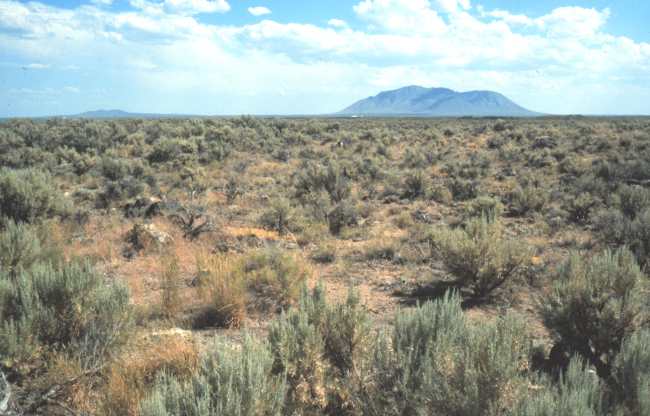
View of Big Southern Butte (background) and rangeland (foreground) of the Eastern Snake River Plain south of the INEEL
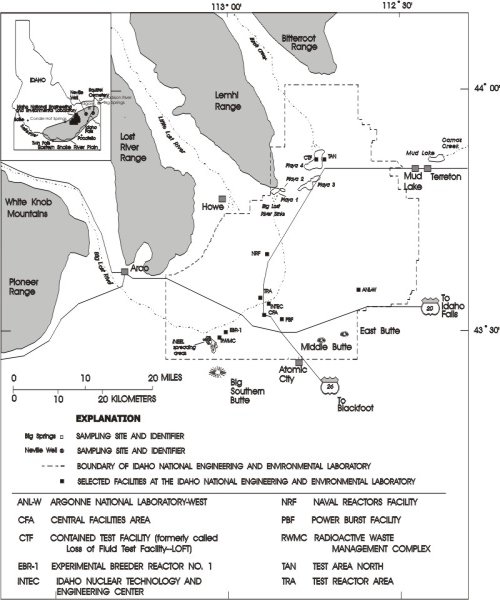
Location of Idaho National Laboratory, selected sampling sites, and selected facilities.
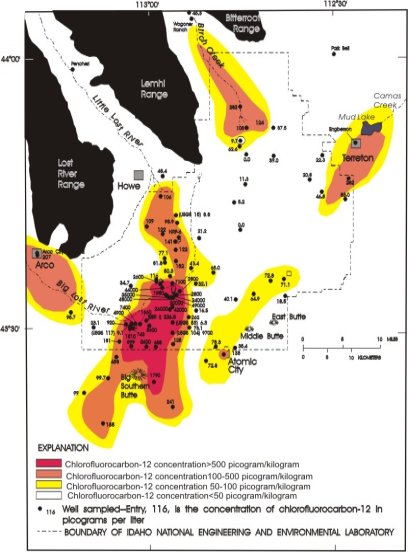
Concentration of chlorofluorocarbon-12 in ground water, Idaho National and vicinity.
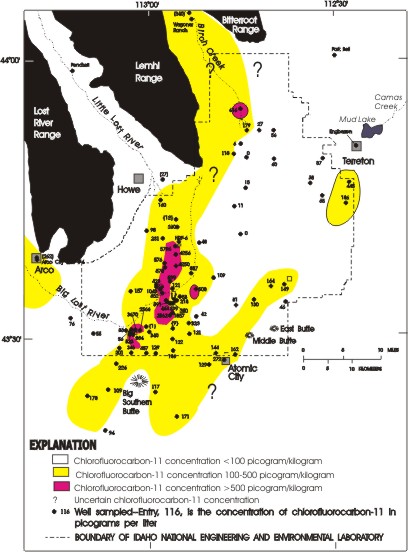
Concentration of chlorofluorocarbon-11 in ground water, Idaho National Laboratory and vicinity.
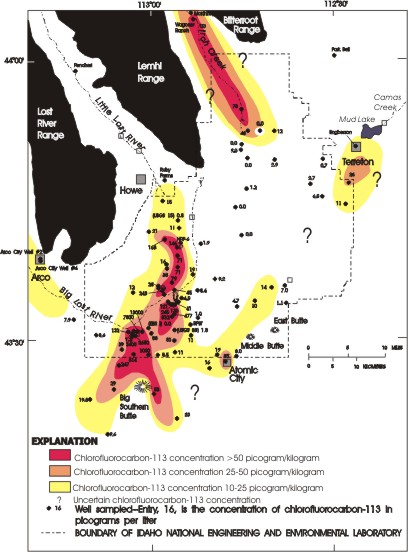
Concentration of chlorofluorocarbon-113 in ground water, Idaho National Laboratory and vicinity.
Investigators:
Eurybiades Busenberg, L. Niel Plummer (U.S. Geological Survey, 432 National Center, Reston, VA 20192), Roy C. Bartholomay, and L. Dewayne Cecil (U.S. Geological Survey, INEEL, MS 1160, P. O. Box 2230, Idaho Falls, ID 83403).
Publications:
Busenberg, E., Weeks, E.P., Plummer, L.N., and Bartholomay, R.C., 1993, Age dating ground water by use of chlorofluorocarbons (CCl3F and CCl2F2), and distribution of chlorofluorocarbons in the unsaturated zone, Snake River Plain aquifer, Idaho National Engineering Laboratory, Idaho. U.S. Geological Survey Water-Resources Investigations 93-4054, 47p.
Busenberg, E., Plummer, L.N., Bartholomay, R.C., and Wayland, J.E., 1998, Chlorofluorocarbons, sulfur hexafluoride and dissolved permanent gases in ground water from selected sites at and near the Idaho National Laboratory, Idaho, 1994 - 97. U.S. Geological Survey Open-File Report 98-274, 72p.
Busenberg, E., Plummer, L.N., Doughten, M. W., Widman, P. K., and Bartholomay, R.C., 2000, Chemical, isotopic compositions, and gas concentrations of ground water at and near the Idaho National Engineering and Environmental Laboratory, Idaho, 1994-97. U.S. Geological Survey Open-File Report 00-81, 55p.
Chlorofluorocarbons, sulfur hexafluoride, and dissolved permanent gases in ground water from selected sites at and near the Idaho National Laboratory, Idaho, 1994 through 1997 (U.S. Geological Survey Open-File Report 98-274, (DOE/ID-22151), 72p., 1998)